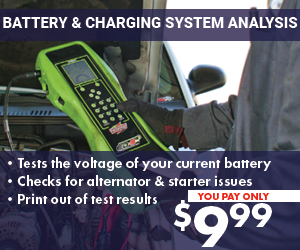Recent Posts
Batteries and Charging System
Get The Right Battery For Your Vehicle
Battery - When your car's engine is off, the battery provides the required power to the rest of the system, as well as during start-up (cranking). It also supplements the power from the charging system during periods of high demand.
Charging System - This is the heart of the electrical system. It consists of three main components: the belt-driven alternator, various electrical circuits, and a voltage regulator. The alternator supplies power to the electrical system and recharges the battery after your car has started. Just like it sounds, the voltage regulator controls the voltage, keeping it within the operating range of the electrical system.
Starting System - This system consumes more electrical power than any other in your car. The starting system consists of three components which work in tandem: the ignition switch, the starter relay or solenoid, and the starter motor. The ignition switch controls the starter solenoid, which activates the starter motor. The starter motor then turns the engine until your car starts.

- Download Coupon
- Weekly Specials
- Click To Call A Service Advisor
- Find A Location Nearest You
What does the battery light on the dashboard mean?
Every car today contains a rechargeable 12-volt battery. This battery powers everything electrical: the engine's control computer, the ignition system, the radio, the headlights, etc. So the battery is vital to the car's operation.
Like all batteries, a car's 12-volt battery would eventually go dead if it were not recharged, so your car has a built-in recharging system. Most cars have an alternator, along with a voltage regulator, that keeps the battery charged and also provides electricity to the vehicle when the engine is running. A typical alternator can put out between 500 and 1,000 watts when necessary.
Because your car is so dependent on the battery, all cars have a battery light on the dashboard that is designed to warn you if the recharging system fails. A simple circuit looks at the voltage that the alternator is producing, and turns the battery light on if it is low. The battery light indicates a battery charging problem. If the battery light comes on and stays on while you are driving, the most common cause is a broken alternator belt. Total failure of the alternator is another possibility.
The reason why your car can operate normally even though the battery light is on is because your car can run off the energy stored in the battery. Your car will run fine until the battery goes dead. At that point, nothing in your car will work. When the battery light is on, you can still drive your car to the garage -- you will not damage anything. But you want to get to the garage before the battery fails and your car dies.
The whole "starting your car in cold weather" thing can be a big problem for people who live up north, and especially for people who live in really cold places like Alaska. There are three reasons why cars are hard to start when it is cold.
Reason 1 - Gasoline, like any other liquid, evaporates less when it is cold. You have seen this -- if you pour water onto a hot sidewalk it will evaporate a lot faster than it will from a cooler place like a shady sidewalk. When it gets really cold, gasoline evaporates slowly so it is harder to burn it (the gasoline must be vaporized to burn). Sometimes you will see people spray ether into their engines in cold weather to help them start -- ether evaporates better than gasoline in cold weather.
Reason 2 - Oil gets a lot thicker in cold weather. You probably know that cold pancake syrup or honey from the refrigerator is a lot thicker than hot syrup or honey. Oil does the same thing. So when you try to start a cold engine, the engine has to push around the cold, gooey oil and that makes it harder for the engine to spin. In really cold places people must use synthetic motor oils because these oils stay liquid in cold temperatures.
Reason 3 - Batteries have problems in cold weather, too. A battery is a can full of chemicals that produce electrons (see How Batteries Work for more information). The chemical reactions inside of batteries take place more slowly when the battery is cold, so the battery produces fewer electrons. The starter motor therefore has less energy to work with when it tries to start the engine, and this causes the engine to crank slowly.
All three of these problems can make it impossible to start an engine in really cold weather. People either keep their cars in heated garages or use "block heaters" to get around these problems. A block heater is a little electric heater that you plug into the wall to keep the engine warm.



